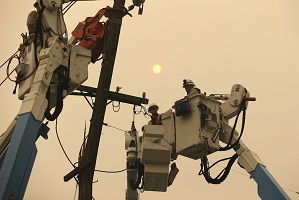California needs tougher laws and enforcement to ensure utility companies bury power lines and trim trees in areas most frequently subject to fire-prevention power shutoffs, a California state audit report has found.
The audit report comes as the fire season, which appears to start earlier with each passing year due to climate change, approaches in California. The state has seen devastating utility-caused wildfires in recent years, including the Dixie Fire that burned more than 963,000 acres last year, making it the second largest in state history. Investigators blamed the fire on power lines owned by Pacific Gas and Electric.
Fires sparked by PG&E power lines have burned more than 1.5 million acres and killed more than 100 people in California since 2015. The audit report released Thursday scrutinized efforts by two state agencies — the California Public Utilities Commission and the Office of Energy Infrastructure Safety — that approve investor-owned utilities’ wildfire mitigation plans and evaluate their implementation of those plans.
The report identified a flawed process for approving wildfire safety plans, haphazard reviews of utilities’ fire-prevention work, inconsistent enforcement of safety violations and a failure to make sure utilities prioritize hardening power lines in the highest-risk areas. It also concluded the Energy Safety Office awarded safety certifications to utilities, despite finding serious deficiencies in their wildfire mitigation plans.
“The [Energy Safety] office approved plans despite some utilities’ failure to demonstrate that they are appropriately prioritizing their mitigation activities, and subsequent reviews have found that some utilities failed to focus their efforts in high fire-threat areas,” acting California State Auditor Michael Tilden wrote in a letter about the report.
From 2013 to 2021, investor-owned utilities like Pacific Gas and Electric triggered 67 public safety power shutoffs affecting more than 3.6 million customers. Those shutoffs are designed to be a last resort for preventing fires during dry and windy conditions in high-risk areas.
According to the audit, the existence of 40,000 miles of bare power lines in high fire-danger zones has contributed to the need for more frequent power blackouts. A new state law that took effect in January requires utilities to identify sections of power lines where shutoffs occur more frequently and to explain what has been done or is planned to reduce the impact of future power blackouts.
“The State could strengthen this law by requiring utilities to identify what is necessary to prevent future power shutoffs if the conditions leading to those shutoffs were to occur again,” the audit states. The report also found the CPUC did not consistently impose penalties when it found utilities committed safety violations. Additionally, the audit faulted the Energy Safety Office for not requiring utilities to clearly identify in their safety plans where wildfire mitigation activities will occur.








